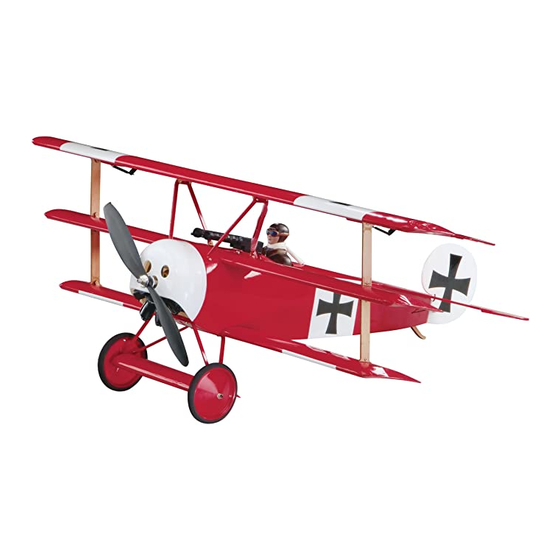GREAT PLANES fokker DR-1 Manuale di istruzioni - Pagina 16
Sfoglia online o scarica il pdf Manuale di istruzioni per Giocattolo GREAT PLANES fokker DR-1. GREAT PLANES fokker DR-1 20.

Warning! Once the battery is connected to the ESC, stay
clear of the propeller even if the ESC has not been armed.
Set the Control Throws
Use a Great Planes AccuThrow (or a ruler) to accurately
measure and set the control throw of each control surface
as indicated in the chart that follows. If your radio does not
have dual rates, we recommend setting the throws at the
low rate setting.
Note: The throws are measured at the widest part of the
elevators, rudder and ailerons.
These are the recommended control surface throws:
High Rate
ELEVATOR:
3/8" [10mm] up
3/8" [10mm] down
RUDDER:
1" [25mm] right
1" [25mm] left
AILERONS:
3/8" [10mm] up
3/8" [10mm] down
IMPORTANT: The Fokker DR-1 EP ARF has been
extensively fl own and tested to arrive at the throws at
which it fl ies best. Flying your model at these throws will
provide you with the greatest chance for successful fi rst
fl ights. If, after you have become accustomed to the way
the Fokker DR-1 EP ARF fl ies, you would like to change
the throws to suit your taste, that is fi ne. However, too much
control throw could make the model diffi cult to control, so
remember, "more is not always better."
Balance the Model (C.G.)
More than any other factor, the C.G. (balance point) can
have the greatest effect on how a model fl ies, and may
determine whether or not your fi rst fl ight will be successful.
If you value this model and wish to enjoy it for many fl ights,
DO NOT OVERLOOK THIS IMPORTANT PROCEDURE.
A model that is not properly balanced will be unstable and
possibly unfl yable.
At this stage the model should be in ready-to-fl y condition
with all of the systems in place including the motor, landing
gear, motor battery, and the radio system.
❏
1. Use a felt-tip pen or 3mm-wide [1/8"] tape to accurately
mark the C.G. on the bottom of the top wing on both sides
of the fuse. The C.G. is located 51mm [2"] back from the LE
of the top wing.
Low Rate
1/4" [6.4mm] up
1/4" [6.4mm] down
5/8" [16mm] right
5/8" [16mm] left
1/4" [6.4mm] up
1/4" [6.4mm] down
16
This is where your model should balance for the fi rst fl ights.
Later, you may wish to experiment by shifting the C.G. up to
3mm [1/8"] forward or 3mm [1/8"] back to change the fl ying
characteristics. Moving the C.G. forward may improve the
smoothness and stability, but the model may then require
more speed for takeoff and make it more diffi cult to slow
for landing. Moving the C.G. aft makes the model more
maneuverable, but could also cause it to become too
diffi cult to control. In any case, start at the recommended
balance point and do not at any time balance the model
outside the specifi ed range.
❏
2. If you are balancing the Fokker DR-1 EP ARF on the
Great Planes CG Machine, you will fi nd that the angle of
the supports does not allow you to rest the plane forward
enough to reach the balance point. To remedy this, simply
place the front of the CG Machine on a raised surface
(approx. 2" [51mm]). This will allow the plane to be placed
further forward on the balancer.
❏
3. If the tail drops, the model is "tail heavy" and the motor
battery and/or receiver must be shifted forward or weight must
be added to the nose to balance. If the nose drops, the model
is "nose heavy" and the motor battery and/or receiver must
be shifted aft or weight must be added to the tail to balance.
If possible, move the receiver forward or aft to minimize or
eliminate any additional ballast required. If additional weight
is required, use Great Planes "stick-on" lead (GPMQ4485). A
good place to add stick-on nose weight is under the battery
cover (don't attach weight to the cowl–it is not intended to
support weight). Begin by placing incrementally increasing
amounts of weight on the bottom of the fuse over the fi rewall
until the model balances. Once you have determined the
amount of weight required, it can be permanently attached.
If required, tail weight may be added by cutting open the
bottom of the fuse and gluing it permanently inside.
IMPORTANT: If you found it necessary to add any weight,
recheck the C.G. after the weight has been installed.
